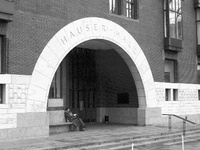Eventually, a portrait of Helen Keller was placed in the building. The portrait of the first blind graduate of Radcliffe had previously resided in Georgene Herschbach’s office.
Other women have also found their way onto Harvard’s walls. Amy Lowell watches over the Lowell House dining hall and Emily Dickinson hangs in Houghton Library. And several portraits of women have ascended to a spot on the walls of the Faculty Club—a building whose doors were barred to women until 1963. This year, the University added two new portraits of women to its collection.
Several of Harvard’s most prominent buildings, such as Widener Library and Sever Hall, were funded by donations from women. But in both of these cases, the buildings were constructed to commemorate the men in these women’s lives—in the case of Mrs. Widener, her son, in the case of Mrs. Sever, her husband.
To better highlight women’s achievements, the University could start a new trend of commissioning portraits of women who are making an impact at Harvard today, says Curator of the University Portrait Collection Sandra Grindlay.
But some argue that the portrait itself is a monument ill-suited for honoring the women who have helped to shape Harvard’s history.
“[The portrait] is a form of history as biography of the great man that perpetuated the 17th, 18th and 19th centuries of hanging someone on the wall,” says Phillips Professor of Early American History Laurel T. Ulrich.
Ulrich says she would rather see photographs of women in action.
“I’m more interested in this activist dynamic of women’s sports teams, women marching in suffrage parades, making bandages during World War I,” Ulrich says, noting that there are thousands of such photos in Harvard’s archives that she says could be more widely displayed throughout the Harvard community.
Ulrich says a less conventional monument that the University could use as a model is the Anne Dudley Bradstreet Gate, located along the North border of the Yard near Canaday, which was dedicated to the 25th anniversary of the integration of women into Harvard’s houses. But Bradstreet had no affiliation with the University and, in the future, Ulrich says, Harvard might better look to name gates after women affiliated with the institution.
Another model Ulrich suggests is the “Women’s Table,” a Yale sculpture designed by Maya Lin that celebrates the achievements of women at the university.
THE UN-HUNG HEROES
Most agree that there are myriad women—past and present—who have made great contributions to the history of Harvard and yet remain conspicuously out of the limelight.
There is, for example, no monument to Anne Hutchinson, the zealous Puritan woman whose challenges to the Puritan clergy of Boston were a large part of the inspiration behind the founding of a college in Cambridge.
No portrait or statue honors Abby Leach, the ambitious young woman who in 1878 sought out the instruction of three separate Harvard professors.
And a portrait of Mrs. Samuel Ripley, who tutored Harvard preparatory students to supplement her husband’s income, hangs in poor condition on the wall of the office of Jane Knowles, interim director of Radcliffe’s Schlesinger Library.
Read more in News
Pataki: 'Yale is Going to Crush Harvard'













